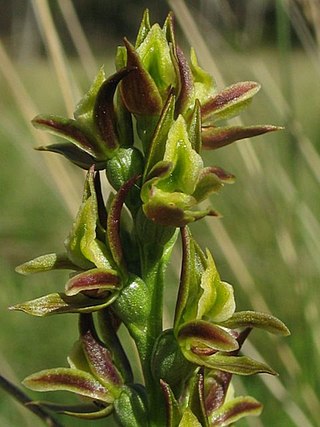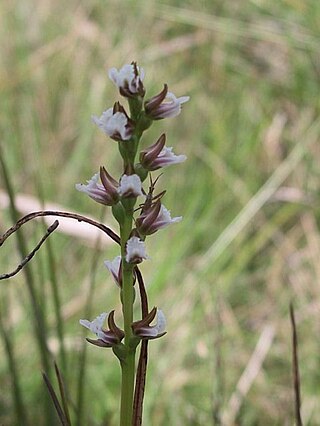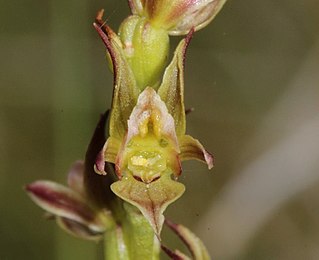Prasophyllum correctum, commonly known as the gaping leek orchid or Bairnsdale leek orchid, is a species of orchid species endemic to a small region in Victoria. It has a single dark green, tube-shaped leaf and up to twenty strongly scented, yellowish-green flowers and is only known from railway reserves near Bairnsdale.
Prasophyllum bagoense, commonly known as Bago leek orchid, is a species of orchid endemic to a small area of southern New South Wales. It has a single tubular, green leaf and up to thirty scented, pale tawny green flowers on a flowering stem. It grows in subalpine grassland in a single population near Tumbarumba.

Prasophyllum wilkinsoniorum is a species of orchid endemic to New South Wales. It has a single tubular, bright green leaf and up to forty five scented, dark greenish-brown to brownish-red flowers with a green to pinkish labellum. It grows in grassy places in a restricted area on the Southern Tablelands.

Prasophyllum canaliculatum, commonly known as the channelled leek orchid or summer leek orchid, is a species of orchid endemic to a small area of southern New South Wales. It has a single tubular, bright green leaf and up to twenty five scented, greenish-red or brownish flowers on a flowering stem. It grows in woodland at altitudes around 1,000 m (3,000 ft) where only about two hundred plants survive.

Prasophyllum caricetum, commonly known as the Cathcart leek orchid, is a species of orchid endemic to a small area of southern New South Wales. It has a single tubular, bright green leaf and up to twenty five green, white and purplish flowers crowded on the flowering stem. It grows in montane swamps near Cathcart.

Prasophyllum colensoi is a species of orchid endemic to New Zealand where it is commonly known as the leek orchid. It has a single tubular, dark green leaf and up to twenty scented, yellowish-green to reddish-brown flowers. It is similar to P. hectori, the only other species of Prasophyllum found in New Zealand, but is distinguished from it by its smaller size, fewer flowers and different habitat.
Prasophyllum fosteri, commonly known as the Shelford leek orchid, is a species of orchid endemic to a small region of Victoria. It has a single tubular green leaf and up to twenty five green to reddish-brown flowers. It is a very rare orchid, only known from a single population on a roadside.

Prasophyllum frenchii, commonly known as the maroon leek orchid or swamp leek orchid, is a species of orchid endemic to south-eastern continental Australia. It has a single tubular green leaf and up to sixty five green, reddish-brown or red flowers. Formerly more widespread, it is now confined to seven populations containing a total of fewer than 1,000 plants.
Prasophyllum gibbosum, commonly known as the humped leek orchid, is a species of orchid endemic to the south-west of Western Australia. It is a late-flowering leek orchid with a single smooth, tubular leaf and up to eighty or more purplish-red and white flowers with a smooth labellum. It is similar to P. cucullatum but that species has a frilly labellum, usually a shorter flowering stem and an earlier flowering period.
Prasophyllum innubum, commonly known as the Brandy Mary's leek orchid, is a species of orchid endemic to a small region of New South Wales. It has a single tubular, bright green leaf and up to twenty brownish-green, white and purplish flowers. It is a very rare orchid with only about four hundred plants known.
Prasophyllum keltonii, commonly known as Kelton's leek orchid, is a species of orchid endemic to a small region of New South Wales. It has a single tubular, bright green leaf and up to twenty two scented, green, brownish-red or purplish flowers. It is a very rare orchid with only a few hundred plants known.

Prasophyllum morganii, commonly known as the Cobungra leek orchid, is a species of orchid endemic to a small area in Victoria. It has a single tubular leaf and up to eighty greenish flowers with purplish markings. Before being rediscovered in 2020, the plant had last been seen in 1933 and was presumed extinct.
Prasophyllum niphopedium, commonly known as the marsh leek orchid, is a species of orchid endemic to a small area in Victoria. It has a single tubular leaf and up to twenty greenish flowers with reddish markings. It is only known from five population on grassy alpine plains with the total number of individual plants less than five hundred.
Prasophyllum odoratissimum, commonly known as the scented leek orchid or fragrant leek orchid, is a species of orchid endemic to Western Australia. It has a single smooth, tubular leaf and up to thirty or more scented, greenish, white and fawn-coloured flowers with a labellum which is often bent backwards. It was formerly included in Prasophyllum odoratum.
Prasophyllum retroflexum, commonly known as the congested leek orchid or Kiandra leek orchid, is a species of orchid endemic to a small area near the border between New South Wales and Victoria, growing in subalpine herbfields. It has a single tubular leaf and up to forty densely-crowded, pale green flowers with pinkish markings.
Prasophyllum taphanyx, commonly known as the graveside leek orchid, is a species of orchid endemic to a small area of Tasmania. It has a single tubular, green leaf and up to twenty five small, light green, pinkish-cream and purplish flowers. It rarely flowers and the largest number of flowers seen in any one year was three in 2001.
Prasophyllum uvidulum, commonly known as the summer leek orchid, is a species of orchid endemic to Victoria. It has a single, tubular leaf and up to twenty five scented, pale green flowers with reddish markings and is only known from a swamp in the north-east of the state.
Prasophyllum mimulum, commonly known as the highland leek orchid, is a species of orchid endemic to Tasmania. It has a single tubular, green leaf and up to ten greenish-brown to purplish flowers with purple and white petals and a white labellum. It is restricted to subalpine areas of the state.
Prasophyllum murfetii, commonly known as the Fleurieu leek orchid, is a species of orchid endemic to South Australia. It has a single tubular leaf and up to thirty five greenish-brown, pink and white flowers. It only grows around the edges of swamps on the Fleurieu Peninsula. It is similar to P. frenchii and was formerly included in that species.
Prasophyllum asinantum is a species of orchid that is endemic to the south-east of South Australia. It has a single dark green leaf and up to five sweetly-scented, greenish-brown flowers with a cream-coloured and green labellum. It only flowers after summer bushfires.








